OPOD - Peru High Sun Halos
OPOD - Peru High Sun Halos: A Rare Atmospheric Phenomenon in the Rainforest
Have you ever heard of high sun halos? Many people believe that these stunning ice halo displays only occur in polar regions or during extremely cold weather. However, this myth has been debunked by captivating images captured over the tropical rainforests of Peru. These photos, taken by Phil Torres for PeruNature.com and Steve Gettle of Wilderness Images, showcase the beauty and wonder of high sun halos in an unexpected location.
On September 23, '12, near the Tambopata Research Center in Peru, these remarkable halos were observed in the sky. Despite the warm tropical climate, high and icy cold cirrus clouds provided the perfect conditions for the formation of these halos. It's important to note that cirrus clouds can occur anywhere on the planet, not just in cold regions.
One distinguishing feature of high sun halos is their appearance when the sun is at a high angle, around 72° in this case. This angle creates a different perspective compared to the more familiar temperate climate halos. The main halo observed is a circumscribed halo, characterized by a sharply colored ring around the sun. This halo is generated by column crystals drifting with their long axes almost horizontal. Although the halo appears nearly circular at high sun, there are faint traces of the truly circular 22° halo within it, caused by randomly oriented crystals.
In addition to the circumscribed halo, there is also a smaller white ring through the sun known as a diminutive version of the parhelic circle. This ring is formed by column and plate-shaped crystals. An unusual sight captured in these images is the Wegener arc looping through the parhelic circle. This arc is not often as bright or extensive, making it a rarity to witness.
Beneath the sun, two huge colored arcs can be seen. The lower arc, always parallel to the horizon, is known as a circumhorizon arc. This arc is formed by sun rays passing through plate-shaped ice crystals. Curving upwards from the circumhorizon arc is a rarer halo called a high-sun infralateral arc. This arc is formed by rays passing between the end and side faces of horizontal column crystals. The simulation provided below helps identify and understand these different halo formations.
The HaloSim computer ray tracing program plays a crucial role in analyzing and recreating these atmospheric phenomena. By tracing millions of rays through mathematical representations of cloud ice crystals, researchers can gain insights into the intricate mechanisms behind high sun halos.
In conclusion, the images captured in Peru's rainforest reveal the enchanting beauty of high sun halos, showcasing that these atmospheric displays can occur even in warm tropical climates. The unique perspective created by the high angle of the sun adds an extra layer of fascination to these halos. By studying and understanding the formation of these halos, scientists and enthusiasts alike can deepen their knowledge of atmospheric optics and appreciate the wonders of our natural world.
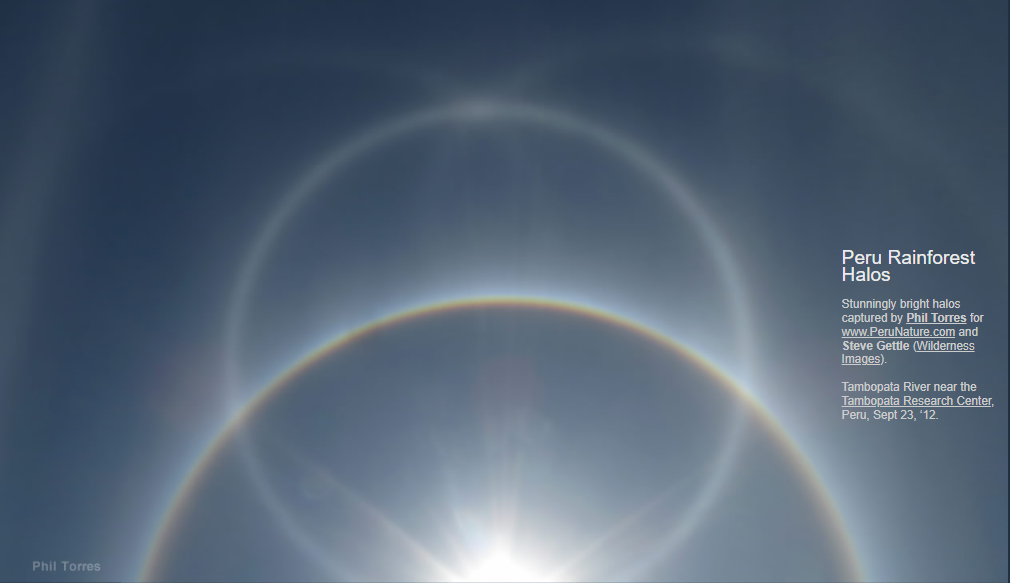
Peru Rainforest Halos
Stunningly bright halos captured by Phil Torres for www.PeruNature.com and Steve Gettle (Wilderness Images).
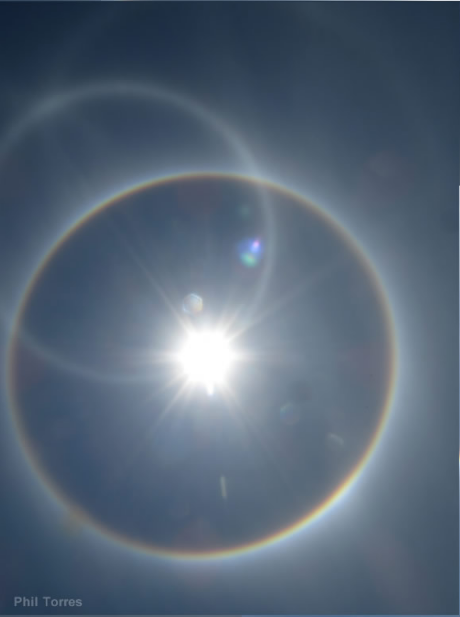
Tambopata River near the Tambopata Research Center, Peru, Sept 23, ‘12.
Images refuting the myth that magnificent ice halo displays are only the stuff of Polar regions or at least very cold weather. These, over the tropical rainforests of Peru were in high and icy cold cirrus cloud which occurs anywhere on the planet.
The sun was ~72° high and the halos therefore differ from their more familiar temperate climate aspect. The sharply coloured ring around the sun is a circumscribed halo generated by column crystals drifting with their long axes almost horizontal. At high sun the halo is nearly circular but there are traces of the truly circular 22° halo (from randomly oriented crystals) within it.
The smaller white ring through the sun is a diminutive version of the normally huge parhelic circle. It is formed by column and plate shaped crystals. A rarity is the Wegener arc looping through the parhelic circle. Not often so bright or extensive. More halos were beneath the sun. Scroll down for these and the labelled HaloSim computer ray tracing.
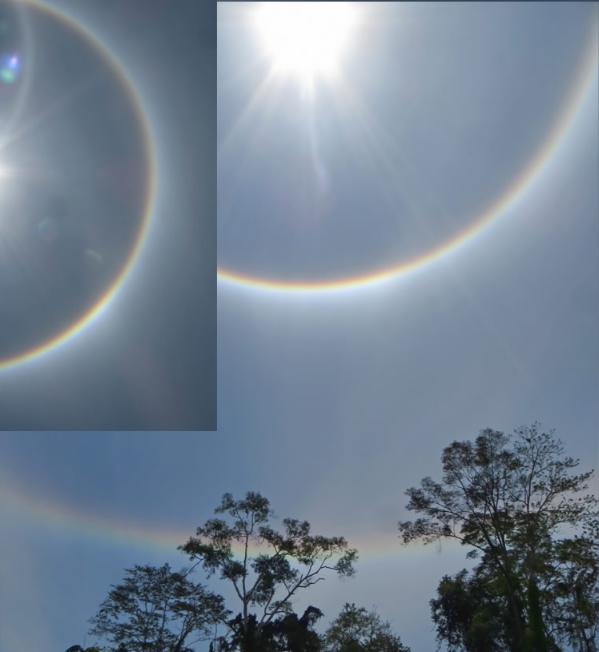
Close-up of the brightly coloured circumscribed halo.
When the sun is high this is often mistaken for the common 22° circular halo but the latter's colours are less saturated and slightly more widely spread.
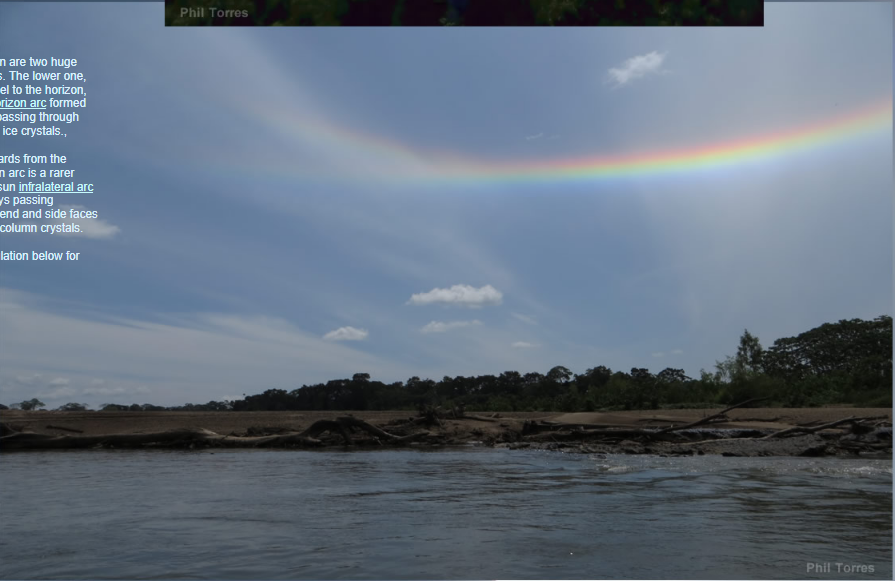
Below the sun are two huge coloured arcs. The lower one, always parallel to the horizon, is a circumhorizon arc formed by sun rays passing through plate shaped ice crystals.,
Curving upwards from the circumhorizon arc is a rarer halo, a high-sun infralateral arc formed by rays passing between the end and side faces of horizontal column crystals.
See the simulation below for identification.
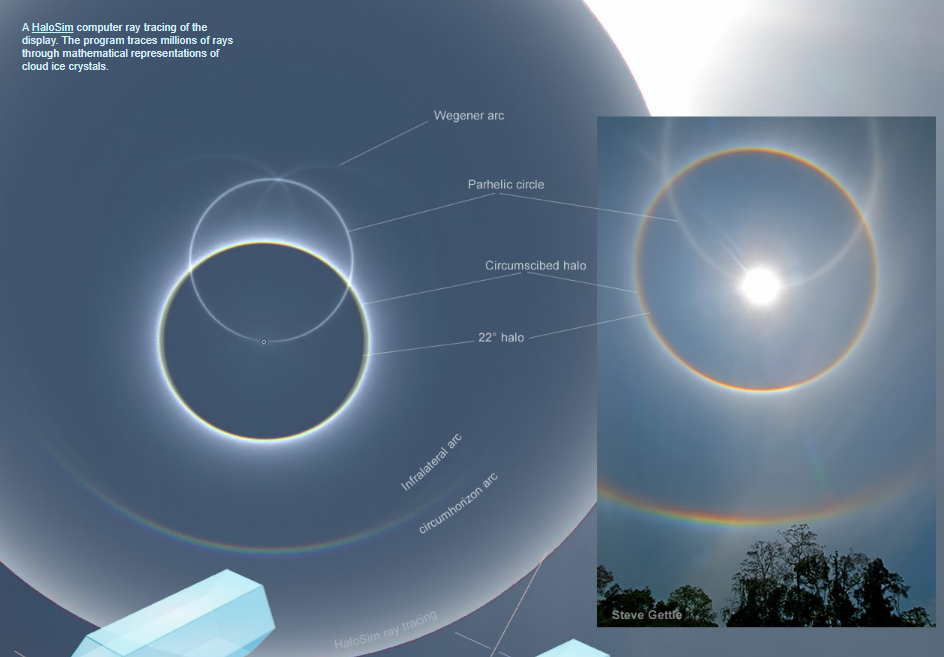
A HaloSim computer ray tracing of the display. The program traces millions of rays through mathematical representations of cloud ice crystals.
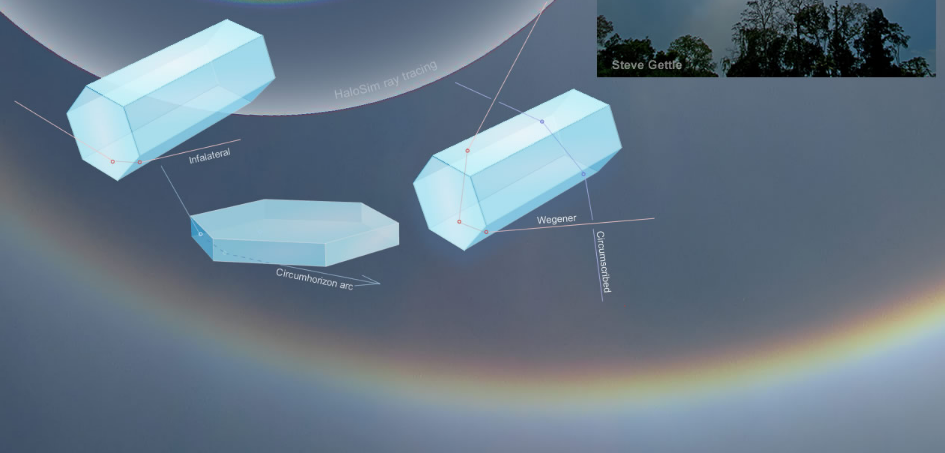
Note: this article has been automatically converted from the old site and may not appear as intended. You can find the original article here.
Reference Atmospheric Optics
If you use any of the definitions, information, or data presented on Atmospheric Optics, please copy the link or reference below to properly credit us as the reference source. Thank you!
-
<a href="https://atoptics.co.uk/blog/opod-peru-high-sun-halos/">OPOD - Peru High Sun Halos</a>
-
"OPOD - Peru High Sun Halos". Atmospheric Optics. Accessed on April 28, 2024. https://atoptics.co.uk/blog/opod-peru-high-sun-halos/.
-
"OPOD - Peru High Sun Halos". Atmospheric Optics, https://atoptics.co.uk/blog/opod-peru-high-sun-halos/. Accessed 28 April, 2024
-
OPOD - Peru High Sun Halos. Atmospheric Optics. Retrieved from https://atoptics.co.uk/blog/opod-peru-high-sun-halos/.